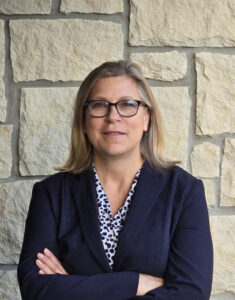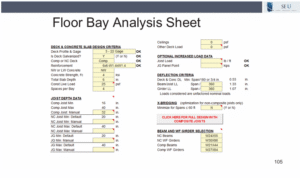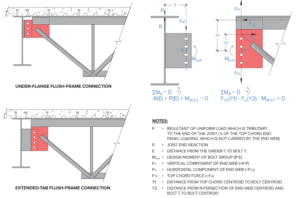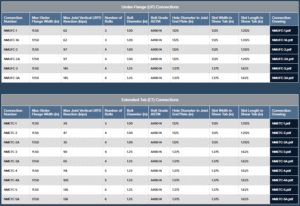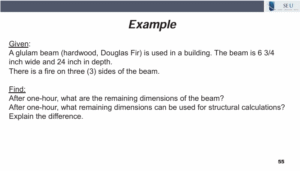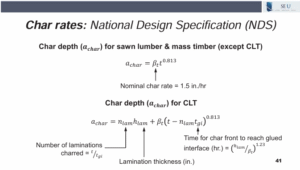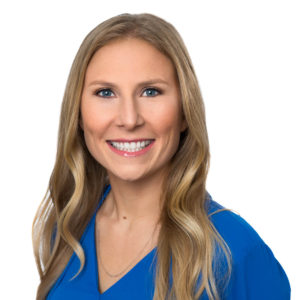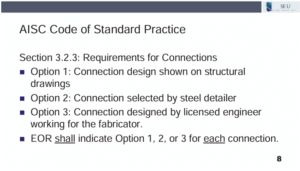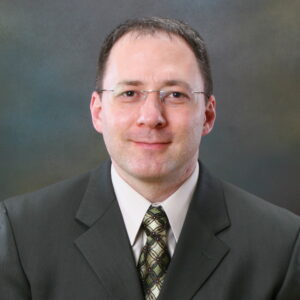In April 2025, Kimberly W. Kramer, PhD, PE, SE, from Kansas State University, presented Designing for Openings in Wood Diaphragms. She nominated Purple Power Animal Welfare Society (Purple Power Animal Welfare Society Rescuing Homeless Pets) for the SEU Speaker Inspires donation of the month.
Kimberly shared, “I selected Purple Power Animal Welfare Society because of the incredible work they do as an all-volunteer, foster-based rescue organization that supports no-kill shelters for homeless cats and dogs in the Manhattan and Junction City area. Their outreach programs, like Pet Away Stress in partnership with K-State Counseling Services and P.A.W.S., bring therapy dogs to campus to help students recharge during high-stress times like midterms. I also value how their mission aligns with Kansas State University’s commitment to animal care, including programs like the Perpetual Pet Care Program in the College of Veterinary Medicine, which ensures pets receive a lifetime of medical care and loving homes when owners are no longer able to provide care. Supporting Purple PAWS is a meaningful way to positively impact both animals and our community.”
Thank you, Kimberly, for helping structural engineers with your SE University session, and for your designation of Purple Power Animal Welfare Society as our SEU Speaker Inspires Organization of the Month!
SE University began the SEU Speaker Inspires program in 2015 as a way to “pay it forward”, enabling our speakers to designate a charity/organization of their choice for SE University to make a donation to help improve our world.
Are you aware of the many advantages of using open web steel joists to achieve a high performance floor? In many cases, steel joists are an economical solution to reduce the overall steel weight, reduce floor-to-floor heights, reduce costs, and produce a flatter finished floor with improved vibration characteristics. In the past, engineers have faced vibration issues using open web steel joists, due to the lighter overall floor system, however, improvements in design and construction techniques have leveraged the advantages of steel joists to produce an economical and better performing building structure.
In the August 2025 SEU session, Joe Pote, PE, from New Millennium, and Dave Samuelson, PE, retired from Nucor, presented Composite Floor Joist Systems. Joe and Dave explained what spacings and depths work best for open web steel joists in floors and how to decrease the floor-to-floor height while increasing the joist depth. They also discussed the advantages of flush-frame joist connections in floor construction. Joe and Dave shared a useful new tool which compares the performance and costs of different steel framing options which is now available through the Steel Joist Institute (SJI).
Available as a free download from SJI, the Floor Bay Comparison Tool – With Vibration can be used to analyze composite and non-composite systems composed of joists and joist girders or hot-rolled steel sections. The tool also does a vibration analysis and allows the user to compare options to improve the vibration performance of the floor bay. As you can see below, the user must specify the geometry of the bay, as well as loading conditions, deck and slab selection, deflection criteria, and depths of the joists, beams or girders.
To understand the specifics of this tool, the user should first read the Gen Info sheet which answers many FAQs and provided references, and then review the User Notes which explains recommendations, including many related to improving vibration performance. After the floor bay has been analyzed, the user is provided with comparison tables noting the lightest option, peak acceleration ratios, natural frequencies and limit checks are listed and compared, including options for different joist seat depths or flush mounted joists, which can significantly reduce vibrations. The user can then make educated selections for joists or beams, composite or non-composite, to achieve desired floor-to-ceiling heights while reducing overall weight and minimizing vibrations.
SJI provides a number of other design tools which are available as free downloads at their website. Check out these free tools on your next project using joists and joist girders to save valuable design time and lower costs. Another excellent resource is SJI’s Technical Digest 13 – Specification and Design of Composite Steel Joists which includes the design methodology of CJ-Series Composite joists and can be purchased from SJI for use in conjunction with the Second Edition CJ-Series Composite Steel Joists catalog, which is available as a free download.
27 Oct 2025
Flush-Frame Joist Connections
Are you aware of the many advantages of using flush-frame connections for open web steel joists? Not only are flush-frame connections an excellent solution to improve the composite action of girders, they also facilitate panelized erection which can reduce multi-story erection times by half. The floor-to-floor heights are also reduced and flush-frame connections eliminate the need for blocking between joists to transfer shear since the slab is in direct contact with the girders.
In the August 2025 SEU session, Joe Pote, PE, from New Millennium, and Dave Samuelson, PE, retired from Nucor, presented Composite Floor Joist Systems. Joe and Dave explained what spacings and depths work best for open web steel joists in floors and how to decrease the floor-to-floor height while increasing the joist depth. They compared the performance of composite and non-composite joists, and they discussed the advantages of flush-frame joist connections in floor construction.
The significant increase in the use of flush-frame joist connections in the post-Covid boom of e-commerce multi-story office buildings resulted in every major US joist manufacturer learning to mass produce this new joist connection. Using flush-frame joist connections allows the steel deck and concrete slab to be in direct contact with the girder top flange, thus developing the full composite moment of inertia with no reduction from an elevated concrete slab as is the case with a standard joist seat. This results in a more effective girder size and improves the vibration performance of the floor system.
Joe noted there is no standard design procedure offered by SJI for flush-framed connections, however all major joist manufacturers have developed their own design procedures, and many resources are available to aid in the design of flush-frame connections. Joe walked through the process used by New Millennium, and offered some design considerations for the EOR.
Under-flange and extended tab connection tables, as shown below, are offered by joist manufacturers which can be used as design aids to expedite the design process. Although the EOR is solely responsible for the design of the joists and its connections, the joist manufacturer can provide calculations for each of their standard flush-frame connection details to the EOR. New Millennium also offers a Flush-Frame Design Guide on the use of these connections which can be downloaded from their website.
Flush-frame joist connections are used in up to 90% of composite joist floor construction in the US today. Their ability to reduce floor-to-floor heights while improving floor vibration performance, and facilitate the use of panelized erection during construction has prompted a major shift in the design of large scale, multi-story office floor systems.
23 Sep 2025
After the Fire: What’s Left of the Beam?
Condition assessments after a fire often involve determining the load capacity of the remaining structural elements. Are you familiar with the equations used to determine the effective depth of char and the remaining cross-sectional dimensions as prescribed in the NDS for mass timber structural elements?
In the July 2025 SEU session, Erica Fischer, PhD, PE, from Oregon State University presented Hot Topic: The Fire Performance of Mass Timber. Erica reviewed the current code and standard guidance for the fire protection design for mass timber, and noted current research on mass timber and fire to enable performance-based design. She also summarized some challenges with mass timber and fire.
Erica walked through the following example to determine the depth of char and the effective depth of char for a glulam beam exposed to fire.
To hear Erica explain this procedure, watch this short video:
As Erica explained, it is necessary to use the effective depth of char to account for the zero stiffness layer beneath the char. This effective char depth should be used to calculate section properties on reduced cross-sectional dimensions for structural calculations. These equations for the char depth and effective char depths for sawn lumber and mass timber, as well as CLT can be found in the National Design Specification (NDS) in Chapter 16. While both char depth equations are non-linear and proportional to the nominal char rate, CLT also includes factors to account for the lamination thickness, the number of laminations charred, and the time for the char front to reach the glulam interface, as shown below.
This specific equation used for CLT char depths accounts for known gaps in the layers of laminations which accelerates the char rate and gives additional pathways for the fire to propagate. Engineers should be aware of the difference when using CLT members to account for this acceleration in the char rate, to ensure accurate remaining section properties can be established.
In March 2025, Emily Guglielmo, PE, SE, from Martin/Martin, presented Refining Wind Load Approaches for
Non-building Structures. She nominated SEAOC SE Pathways Program (SE Pathways Intro – Structural Engineers Association of California) for the SEU Speaker Inspires donation of the month.
SEAOC’s SE Pathways to the Profession initiative aims to address the disparity of engagement and lack of diversity within the California structural engineering profession. SE Pathways to the Profession brings together students and early career professionals and engages them in dialog about engagement, retention and equity in the structural engineering profession.
Thank you, Emily, for helping structural engineers with your SE University session, and for your designation of SEAOC SE Pathways Program as our SEU Speaker Inspires Organization of the Month!
SE University began the SEU Speaker Inspires program in 2015 as a way to “pay it forward”, enabling our speakers to designate a charity/organization of their choice for SE University to make a donation to help improve our world.
When using delegated connection design, which responsibilities belong to the EOR and which belong to the detailer? Who is ultimately responsible for the adequacy of the connection design and what does the Code of Standard Practice require?
In the May 2025 SEU Session, Kyle Jenkins, PE, from Advantage Structural Engineers, presented Tips for the EOR when Delegating Steel Connection Design. Kyle explained ways to produce better drawings that provide the information needed for safe and efficient delegated connection design. He described the importance of communication in the delegated design process and gave examples of negative outcomes that can come from poor communication. Kyle identified some best practices for setting up and delegating types of shear, moment, and bracing connections.
Kyle referenced the Code of Standard Practice which is located in the back of the steel manual, and specifically noted sections 3 and 4, as it applies to delegated connection design. As you can see in the slide below, Kyle noted that the COSP Section 3.2.3 states the requirements for connections:
Option 3 specifically relates to delegated connection design; however it is worth noting that the COSP requires that the EOR indicate which option is being utilized for each connection. The EOR has the option to design some connections while delegating others. This should be clearly indicated on the drawings so that the fabricator can properly bid the cost.
When using Option 3, the COSP specifies that the EOR supply the necessary information for bidding, which includes connection reactions, whether ASD or LRFD is to be used, and required member reinforcement needed, such as stiffeners and thru-plates. Failure to provide this information can result in inaccurate bidding or costly change orders, and possibly an inadequate design. Kyle noted that Section 4 of the COSP lays the final authority of the connection design on the EOR, as you can see below. This responsibility is fulfilled through the submittal review and approval process.
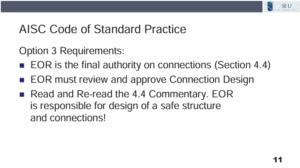 The use of delegated design can only be successful with open lines of communication between the EOR and the detailer. Delays or poor communication can have costly consequences. A team mindset is necessary to ensure the detailer understands the intent of the EOR and is able to provide connections that meet the code standard. However, the EOR is ultimately responsible for the complete design of a safe, code-compliant structure, which includes adequate connections.
The use of delegated design can only be successful with open lines of communication between the EOR and the detailer. Delays or poor communication can have costly consequences. A team mindset is necessary to ensure the detailer understands the intent of the EOR and is able to provide connections that meet the code standard. However, the EOR is ultimately responsible for the complete design of a safe, code-compliant structure, which includes adequate connections.
28 Aug 2025
Delegated Connection Design Done Right
Delegated connection design can be a beneficial way for the EOR to provide a superior product, but only if done correctly. Delegating connections allows the fabricator to use preferred, and often more economical connections, however good communication is necessary to prevent inaccurate bidding, change orders, and delays due to RFIs.
In the May 2025 SEU Session, Kyle Jenkins, PE, from Advantage Structural Engineers, presented Tips for the EOR when Delegating Steel Connection Design. Kyle explained ways to produce better drawings that provide the information needed for safe and efficient delegated connection design. He described the importance of communication in the delegated design process and gave examples of negative outcomes that can come from poor communication. Kyle identified some best practices for setting up and delegating types of shear, moment, and bracing connections.
Kyle noted the importance of providing realistic reactions on design drawings. Accurate reactions lead to more efficient structural designs and decrease costs for the owner. Providing reactions also promotes better quality control for the EOR when reviewing the shop drawing details. To hear Kyle explain this best practice, watch this short video:
Kyle also noted the EOR should specify whether reactions are ASD or LRFD and avoid using terms like “Factored” or “Service” since these terms are no longer relevant as wind and snow loads now are factored to ASD levels. Specifying reactions to be ASD or LRFD eliminates confusion and clear communication prevents negative outcomes.
The burden to provide an efficient and safe design is shared by the EOR and the delegated design professional. Establishing good communication and providing accurate reactions at connections will benefit the team throughout the design and construction administration process.
28 Jul 2025
Stability Bracing and BRBs
Buckling-Restrained Braces are becoming more widely incorporated into seismic designs worldwide. As their use increases, design engineers should be aware of ways to improve the communication and implementation of BRBs into their projects, as well as the code provisions and requirements for the use of BRBs.
In the June 2025 SEU session, Ben Sitler, PE, Dr.Eng., from Buro Happold, presented Seismic Design with BRBs – Pushing to the Limit. Ben noted recent changes to the BRB design and testing provisions of AISC 341-16 and 341-22. Ben explained how BRBs respond in extreme design cases and how to ensure good performance in long and jumbo BRBs, and he reviewed the fundamental behavior of BRBs.
Ben showed how higher-mode buckling and frictional behavior impacts the compressive strains in long BRBs, and how higher strength steel grades may be a valid and even desirable option for large capacity BRBs. He discussed the need for the design engineer to provide stability bracing for BRBs in the scope of their design. While the BRB supplier will perform the necessary stability analysis and physical testing as required on a project-specific basis, the design engineer should communicate with the supplier to discuss what connections or bracing may be required to ensure the BRB is torsionally restrained in both directions. To hear Ben discuss some tips for design engineers providing stability bracing, watch this short video from his presentation:
As Ben discussed, engineers should provide torsional braces and connections on beams framing into BRB connections. Closed beam sections may also be required where diaphragms are absent. Maintaining global stability is essential when using BRBs and the design engineer plays a crucial role in ensuring the framing provided can resist these out of plane forces. Ben also noted that AISC 360 Appendix 6 does provide some guidance on bracing stiffness and strength provisions, however, these were not specifically developed for BRBs and are typically intended for lateral-torsional buckling calculations. While the torsional forces from BRBs are not usually large, they are still present and need adjacent framing to provide resistance.
30 Jun 2025
Wind Provisions for Rooftop Screenwalls
Which section of ASCE 7 do you typically use to determine design wind loads for rooftop screenwalls? Would they be considered roof top equipment? Or perhaps you consider them to be a parapet or a freestanding sign? Does the location on the roof affect which provision to use?
In the March 2025 SEU session, Emily Guglielmo, PE, SE, from Martin/Martin, presented Refining Wind Load Approaches for Non-building Structures. Emily reviewed the applicability of ASCE 7 wind load provisions for rooftop equipment, screenwalls, PV panels, signs and canopies, and other non-building structures. She also addressed ways to approach wind loads on structures not explicitly addressed in ASCE 7 such as trellises, tall parapets, and balcony rails. Emily presented rational analysis strategies to address gaps in code provisions for non-building structures and industry best practices.
Emily addressed a common but often debatable topic: wind loads on screenwalls. Engineers often vary on whether they consider screenwalls to be rooftop equipment, solid freestanding signs, or parapets. Along with confusion on which provision to use, engineers also might wonder whether shielding can be considered on the equipment enclosed within the screenwalls. To hear Emily address how ASCE 7 considers screenwalls and shielding, click below to watch this short video:
While some wind provisions in ASCE 7 are explicit, there are some gray areas especially as it applies to non-building structures which often encompasses unique situations. Screenwalls are not explicitly included in the body of the code, however the commentary provides ample feedback on how to appropriately address these rooftop structures.
In November 2024, SEU welcomed Brad Davis, PhD, SE, PE, from Davis Structural Engineering, to present Vibration Analysis of Steel Joist / Concrete Floors. Previously in 2020, Brad designated Doctors without Borders (https://www.doctorswithoutborders.org/) for our SEU Speaker Inspires donation for the month, and he has chosen to do the same in 2024.
Doctors without Borders, or Medicins Sans Frontieres, provides medical humanitarian aid where the needs are greatest, and often go to places where other organizations can’t or won’t operate. Historically, they have not run medical projects in the US, however in March 2020, MSF launched temporary operations in the United States in response to the unprecedented COVID-19 pandemic. In key sites around the country, MSF is working with local authorities and partner organizations that serve vulnerable communities with limited access to health care, such as migrants, homeless people, and other marginalized or neglected groups
Thank you, Brad, for helping structural engineers with your SEU session, and for your designation of Doctors without Borders as our SEU Speaker Inspires Organization of the Month!
SE University began the SEU Speaker Inspires program in 2015 as a way to “pay it forward”, enabling our speakers to designate a charity/organization of their choice for SE University to make a donation to help improve our world.

